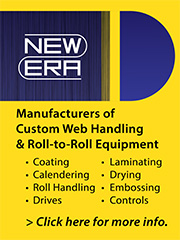Coating Matters | The Advantage of Using Surfactants
- Published: September 06, 2016, By Mark Miller
Surface active agents provide a tie layer between the liquid and the substrate, but trial and error will be required.
If you'd like to hear from Mark Miller's own lips rather than read his column, titled "Coating Matters | The Advantage of Using Surfactants," click on his podcast below:
{mp3}surfactants-voice{/mp3}
![]() In the world of liquid coating, the ability of the liquid to adhere to the substrate is not ideal. The liquid does not want to flow correctly, beading up or generally not behaving well at the interface between the liquid coating and the substrate. In roll-to-roll coating, there is an air layer that the liquid is trying to push away so it can sit nicely on the substrate and cure into place as a web coated product. If the surface energy of the substrate and the surface tension of the fluid is not a good match, this air removal won’t happen and air-based coating defects occur.
In the world of liquid coating, the ability of the liquid to adhere to the substrate is not ideal. The liquid does not want to flow correctly, beading up or generally not behaving well at the interface between the liquid coating and the substrate. In roll-to-roll coating, there is an air layer that the liquid is trying to push away so it can sit nicely on the substrate and cure into place as a web coated product. If the surface energy of the substrate and the surface tension of the fluid is not a good match, this air removal won’t happen and air-based coating defects occur.
This is especially true as the chemistries being developed for coating move away from solvent-based and are becoming more and more water-based. Solvent-based liquids tend to have a better surface tension and interfacial chemistry for adsorbing to various web substrates, whereas water-based liquids want to bead up and allow air into the mix. So what is a chemist to do? Or more importantly, what can a process engineer suggest to help the chemist develop a process-able liquid?
Surfactants are shorthand for the term “surface active agents” and can be added in small quantities to overcome the imbalance in surface energy of the substrate and the surface tension of the fluid. Of course, many times, the surface energy of the substrate can be altered to improve adsorption of the liquid. But if the substrate is controlled, and the product is still failing, surfactants provide an alternative solution.
In addition to surfactants modifying the surface tension of the fluid, they also can control the hydrophilic or hydrophobic nature of the fluid to develop the balance required for adsorptive equilibrium. The key is to add the amount required to restore balance and control between the liquid and the substrate. This stabilization energy required to hold the liquid on the substrate is lost in aqueous solutions because a majority of the energy required for adsorption is utilized to simply hold the water molecules together.
You can think of the surfactant as a tie layer between the water molecules and the substrate surface. The amount of surfactant required will be higher for a lower solids content liquid. If the surfactant loading is too high, the wetting phenomenon will be exaggerated, so take care in determining the surfactant loading in the water-based liquid being coated.
This coating improvement chemical provides support more in curtain coating than in meniscus-based coating. The reason being that the liquid is controlled mechanically and chemically in the meniscus system. While in the curtain coating arrangement, the chemistry has a larger effect.
The other consideration is the time to reach equilibrium after coating. The surfactant-filled liquid needs to have enough loading to allow for wetting of the substrate, but not too much, or the wetting will not reach equilibrium in a reasonable time. This will present itself as a overflow of the substrate or drying based coating defect. This time to equilibrium after coating is considered a dynamic surface tension versus the static surface tension typically measured for liquid applications. Understanding and measuring this dynamic surface tension leads to a better understanding of the liquid behavior after coating, and if optimized, provides a basis for dryer coating defect analysis.
By providing both hydrophilic and hydrophobic characteristics, surfactants provide a great advantage in coating as a tie layer between the liquid and the substrate. These features also can provide an attraction to contaminants. The more hydrophilic the coated surface becomes, the more tacky the surface is, and therefore can attract and retain particles in the coating process. So just don’t dump in the surfactant if the coating liquid is not spreading on the substrate! Analysis and trial and error will be required. Typical levels of surfactant loading is 0.02-0.05 molar.
 Mark D. Miller, author of PFFC's Coating Matters column, is a fluid coating expert with experience and knowledge in the converting industry accumulated since 1996. Mark holds a Bachelor's degree in Chemical Engineering from the Univ. of Wisconsin-Madison and a Master's degree in Polymer Science & Engineering from Lehigh Univ. and a Juris Doctor from Hamline Univ. Mark is a technical consultant and CEO of Coating Tech Service LLC. He has worked in web coating technologies and chemical manufacturing operations and is a certified Six Sigma Black Belt trained in both DMAIC and DFSS disciplines. Coating Tech Service provides process troubleshooting and project management for precision coated products. Mark has extensive process knowledge in high precision coating applications including thin film photo voltaic, Li-Ion battery, and optical systems technology. Mark has been integral to new developments and technology that minimize product waste and improve process scalability.
Mark D. Miller, author of PFFC's Coating Matters column, is a fluid coating expert with experience and knowledge in the converting industry accumulated since 1996. Mark holds a Bachelor's degree in Chemical Engineering from the Univ. of Wisconsin-Madison and a Master's degree in Polymer Science & Engineering from Lehigh Univ. and a Juris Doctor from Hamline Univ. Mark is a technical consultant and CEO of Coating Tech Service LLC. He has worked in web coating technologies and chemical manufacturing operations and is a certified Six Sigma Black Belt trained in both DMAIC and DFSS disciplines. Coating Tech Service provides process troubleshooting and project management for precision coated products. Mark has extensive process knowledge in high precision coating applications including thin film photo voltaic, Li-Ion battery, and optical systems technology. Mark has been integral to new developments and technology that minimize product waste and improve process scalability.







